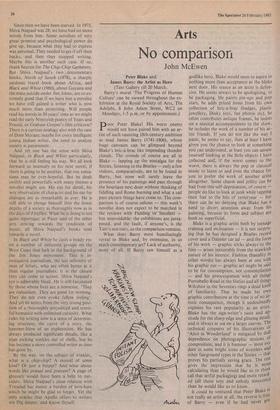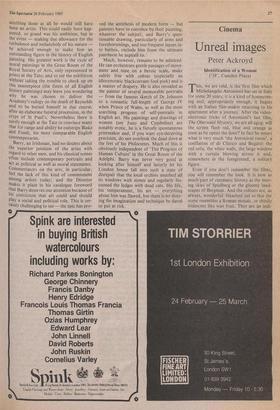Arts
No comparison
John McEwen
Peter Blake and James Barry: the Artist as Hero (Tate Gallery till 20 March. Barry's mural 'The Progress of Human Culture' can be viewed throughout the ex- hibition at the Royal Society of Arts, The Adelphi, 8 John Adam Street, WC2 on Mondays, 1-5 p.m. or by appointment.) Poor Peter Blake! His worst enemy .1 would not have paired him with an ar- tist of such vaunting 18th-century ambition as mad James Barry (1741-1806), whose huge canvases can be glimpsed beyond Blake's bric-a-brac like impending thunder clouds. The crowds of course are all in Blake — lapping up the nostalgia for the Sixties, listening to the Beatles — only a few visitors, comparatively, are to be found in Barry, but none will surely leave the presence of his paintings and pass through the boutique next door without thinking of fiddling and Rome burning and what a sad pass picture things have come to. The com- parison is of course odious — this week's novelist does not expect to be matched in the reviews with Fielding or Smollett but unavoidable: the exhibitions are juxta- posed, and the fault, if anyone's, is the Tate's not ours, so the comparison remains.
What does Barry most humiliatingly reveal in Blake and, by extension, in so much contemporary art? Lack of authority, most of all. If Barry saw himself as a
godlike hero, Blake would seem to aspire to nothing more than acceptance as the bloke next door. His stance as an artist is defen- sive. He seems always to be apologising, to be packaging. He paints pin-ups and pop stars, he adds prized items from his own collection of bric-a-brac (badges, plastic jewellery, Dinky toys, fan photos etc), he often contributes antique frames, he insists on a musical accompaniment to the show, he includes the work of a number of his ar- tist friends. If you do not like the way I paint, he seems to say, then at least I have given you the chance to look at something you can understand, at least you can amuse yourself looking at the little objects I have collected and, if the worst comes to the worst, there is always the pop or classical music to listen to and even the chance for you to prefer the work of another artist altogether. Some charm and jollity can be had from this self-deprecation, of course people do like to look at junk while tapping their feet to the hits of yesteryear — but there can be no denying that Blake has a need to divert attention away from his painting, because its form and subject are both so superficial.
Blake is a graphic artist both by teenage training and inclination — it is not surpris- ing that he has designed a Beatles record cover and a Daimler car ad — and the form of his work — graphic tricks always to the fore — arises inexorably from the mawkish nature of his interest. Fashion (banality in other words) has always been at one with his graphic eye — graphic art might be said to be for consumption, not contemplation — and his preoccupation with all things Portobello Road in the Sixties and all things Wiltshire in the Seventies rings a dead knell of familiarity. That he made his own graphic contribution at the time is of no ar- tistic consequence, though it undoubtedly explains his rare popularity as an artist. Blake has the sign-writer's taste and ap- titude for the sharp edge and glinting detail, and is always at sea on a larger canvas. The technical crispness of his illustrations of `Alice in Wonderland' is mitigated by dull dependence on photographic notions of composition, and it is humour — most evi- dent in some bright icons of wrestlers and other fairground types in the Sixties — that proves his partially saving grace. The rest gives the impression that he is more calculating than he would like us to think (all that artful packaging) and more retard- ed (all those toys and unholy innocents) than he would like us to know.
It could be ventured that Peter Blake is not really an artist at all, the reverse is true of Barry — even if he had never got anything done at all he would still have been an artist. This could easily have hap- pened, so grand was his ambition, but in the event — making due allowance for the turbulence and melancholy of his nature he achieved enough to make him an outstanding figure in the history of English painting. His greatest work is the cycle of mural paintings in the Great Room of the Royal Society of Arts, only represented in prints at the Tate; and to see the exhibition without taking the trouble to check up on this masterpiece (the finest of all English history paintings) may leave you wondering why he was chosen to deliver the Academy's eulogy on the death of Reynolds and to be buried himself in due course, after an elaborate funeral procession, in the crypt of St Paul's. Nevertheless there is surely enough at the Tate to convince many that for range and ability he outstrips Blake and Fuseli, his most comparable English contemporaries.
Barry, an Irishman, had no doubts about the superior position of the artist with regard to other men, and his classical scenes often include contemporary portraits and act as political as well as moral statements. Commentators on the arts, in particular, feel the lack of this kind of commitment among artists today; and the Director makes it plain in his catalogue foreword that Barry deserves our attention because of his conviction that art could and should Play a social and political role. This is cer- tainly challenging to see — the epic has pro-
ved the antithesis of modern form — but painters have to convince by their painting, whatever the subject, and Barry's ques- tionable drawing, particularly of arms and foreshortenings, and too frequent lapses in- to bathos, exclude him from the ultimate pantheon he aspired to.
Much, however, remains to be admired. He can orchestrate gentle passages of move- ment and tone • on a heroic scale, make subtly free with colour (especially an idiosyncratic blackcurrant-fool pink) and is a master of drapery. He is also revealed as the painter of several memorable portraits — from the famous sketch of Dr Johnson to a romantic full-length of George IV when Prince of Wales, as well as the most searching progress of self-portraits in English art. His paintings and drawings of women (see Juno and Cymbeline) are notably erotic, he is a fiercely spontaneous printmaker and, if you want eye-deceiving precision, do not overlook the dead dove at the feet of his Philoctetes. Much of this is obviously independent of 'The Progress of Human Culture' in the Great Room of the Adelphi. Barry was never very good at looking after himself and latterly let his London house fall into such a state of disrepair that the local urchins smashed all its windows with stones and regularly fes- tooned the ledges with dead cats. His life, his temperament, his art — everything about him was flawed, but there is no deny- ing the imagination and technique he dared to put at risk.











































 Previous page
Previous page